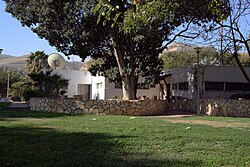Masua: Difference between revisions
Sean.hoyland (talk | contribs) per sign for the settlement on route 90 and RS |
Undid revision 611550768 by Sean.hoyland (talk) |
||
| Line 12: | Line 12: | ||
}} |
}} |
||
'''Masua''' ({{lang-he-n|מַשּׂוּאָה}}, ''lit.'' Torch |
'''Masua''' ({{lang-he-n|מַשּׂוּאָה}}, ''lit.'' Torch) is a [[moshav shitufi]] and [[Israeli settlement]] in the [[West Bank]]. Located in the [[Jordan Valley (Middle East)|Jordan Valley]] with an area of 6,000 [[dunam]]s, it falls under the jurisdiction of [[Bik'at HaYarden Regional Council]]. In 2012 it had a population of 153. |
||
The village was established in 1969 as a [[Nahal settlement]], and was converted to a civilian moshav by a [[HaOved HaTzioni]] [[gar'in]] five years later. |
The village was established in 1969 as a [[Nahal settlement]], and was converted to a civilian moshav by a [[HaOved HaTzioni]] [[gar'in]] five years later. |
||
Revision as of 05:46, 7 June 2014
Masua | |
|---|---|
 | |
| Country | Israel |
| Council | Bik'at HaYarden |
| Region | Jordan Valley |
| Affiliation | HaOved HaTzioni |
| Founded | 1969 |
| Founded by | Nahal |
| Population | 153 |
Masua (Template:Lang-he-n, lit. Torch) is a moshav shitufi and Israeli settlement in the West Bank. Located in the Jordan Valley with an area of 6,000 dunams, it falls under the jurisdiction of Bik'at HaYarden Regional Council. In 2012 it had a population of 153.
The village was established in 1969 as a Nahal settlement, and was converted to a civilian moshav by a HaOved HaTzioni gar'in five years later.
The international community considers Israeli settlements in the West Bank illegal under international law, but the Israeli government disputes this.[1]
Sartava Nature Reserve
Four kilometers west-southwest of Masua is the Sartava Nature Reserve, named in tribute to a mountain from which, in Mishnaic times, Jews would relay signals via torch to indicate that a new month had been proclaimed.
Formerly bonfires were lighted (to announce the appearance of the new moon); but when the Cutheans practiced their deceit, it was ordained that messengers should be sent out. How were these bonfires lighted? They brought long staves of cedar wood, canes, and branches of the olive tree, and bundles of tow which were tied on top of them with twine; with these they went to the top of a mountain, and lighted them, and kept waving them to and fro, upward and downward, till they could perceive the same repeated by another person on the next mountain, and thus, on the third mountain, etc. Whence did these bonfires commence? From the Mount of Olives to Sartabha, from Sartabha to Grophinah, from Grophinah to Hoveran, from Hoveran to Beth Baltin; they did not cease waving the burning torches at Beth Baltin, to and fro, upward and downward, until the whole country of the captivity appeared like a blazing fire.
The summit of Sartava has remains of a fort built by King Alexander of Judea. The area of Sartava, which is split down its length due to the Great Rift Valley, is unique in that it embodies a transition between the Mediterranean habitats of Samaria on the one hand and the more desert-like habitats of the Arava on the other.[3]
See also
References
- ^ "The Geneva Convention". BBC News. 10 December 2009. Retrieved 27 November 2010.
- ^ "Tractate Rosh Hashana: Chapter II". Jewish Virtual Library. American-Israeli Cooperative Enterprise. Retrieved 10 January 2012.
- ^ Hareuveni, Imanuel (1985). קום התהלך בארץ: מדריך שמורות טבע בישראל (in Hebrew) (2nd ed.). Israel: Israel Ministry of Defense. p. 261. ISBN 965-05-0193-2.
שם השמורה – לפי מיקומהּ על הר סרטבה (קרן צרטבה). על פסגת ההר היו משיאים משואות להודיע על חידוש החודש וקידושו." "בראש הר סרטבה, שרידי מצודת אלכסנדריום, אשר נבנתה על-ידי אלכסנדר ינאי ונקראה על שמוֹ." "הקער הזה מבותר לאורכּו – חלק מע' וחלק מז' – על-ידי מערכת השבר הסורי-אפריקני." "שטח השמורה כולל, נוסף לגוש הר סרטבה, גם שטח המייצג מעבר מבתי-גידול ים-תיכוניים בקמר השומרון, לבתי-גידול בבקעת הירדן; מעין פרשת-דרכים, בציר האורך של בקעת הירדן. מכאן מסתעפת מגמת התפשטות של יסודות מדבריים, ערבתיים וטרופים לכיווּן מע', לעבר גב ההר, עד עמק נחל תרצה והמדרונות הפונים אליו.
{{cite book}}: Unknown parameter|trans_title=ignored (|trans-title=suggested) (help)
